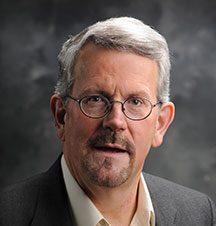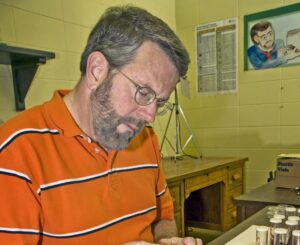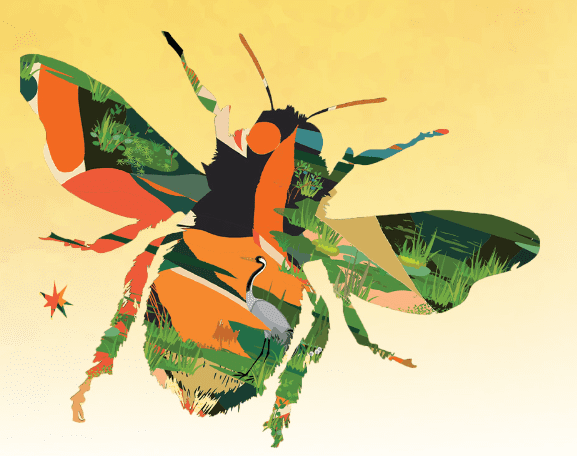
(Photo from Mississippi State University)
Beyond the serious science-based books, the Mississippi State professor also writes fiction – just-for-fun books that teach children about bugs – and also novels that attract adult readers.
Creepy, crawly things—ants invading a nursing home, mites biting a little old lady on her couch, humongous cockroaches attracted to stashed away, half-eaten, spoiled food in a hospital storage space—all and more bugs make most people shudder.
But to Crawley McPherson and his creator, Jerome Goddard, those insects are just part of a day’s work.
Goddard writes words for little kids, public health workers and private practice physicians, and academic and research scientists who like and want to know more about bugs. He also writes about his personal journey to understand faith and science.
A self-described “bug nerd” with speech patterns that resemble those of Gomer Pyle and Barney Fife, Doctor Jerome Goddard not only writes but also speaks extensively, teaches, and conducts research on ticks, bed bugs, mosquitoes, and other arthropods.
Extension professor of medical/veterinary entomology at Mississippi State University, Goddard wrote the first edition of his internationally acclaimed textbook in 1993. His award-winning Physician’s Guide to Arthropods of Medical Importance became not only a standard reference in doctors’ offices and emergency rooms but is now in its seventh edition, offered as The Goddard Guide To Arthropods of Medical Importance. He singly wrote the original and updated early versions but shares authorship of the latest edition with Gail Miriam Moraru and his son Jerome Goddard II.
Marketers introduced the third edition with three personal stories: “A nine-year-old boy suffers a severe allergic reaction to a bee sting. A seemingly healthy teen-aged girl suffers a nervous system disorder caused by Lyme disease. And a construction worker experiences symptoms of chills, fever, and sweating usually associated with malaria. Even in the most industrialized nations, the health problems caused by common insects such as bees, ticks, and mosquitoes pose a serious threat, making quick and accurate diagnosis and treatment imperative.”

Goddard conceived the textbook in his role as Mississippi’s first full-time public health entomologist with the Mississippi State Department of Health (MSDH). From his three-year Air Force career, he knew that bugs carry disease to troops stationed worldwide. His then-new public health job involved his creating a program to supervise entomological (bugology) projects and vector (transmitter) control programs while also investigating insect-transmitted disease outbreaks.
He looked for a “good medical book about insects and health issues related to bugs.” None existed; so, he wrote the book.
An article in PCTOnline, quotes the then-aspiring author: “I became a bug nerd in the library, reading everything there is to know. I was going to conferences and sitting at the front of the room, writing down everything the speakers said. At night, when people went out for dinner and dancing, I was in my room reading my notes from the day’s meetings as well as medical entomology textbooks.”
After three years intense work, he published the book that addresses “increased contact with arthropod species otherwise not commonly encountered” but becoming known through “globalization of commerce, same-day air travel between continents, and military activity in the most remote parts of the world.” Goddard’s guide twice earned “Highly Commended” awards in the British Medical Association Best Medical Book of the Year competitions.
That seminal work catapulted him into near-celebrity status with a feature in Reader’s Digest and appearances on the National Geographic Channel and in a series entitled “Living with Bugs” on the Learning Channel. He became a frequently- and widely-sought speaker on the lecture circuit: Mayo Clinic, Cleveland Clinic, US Congress, and a spot in 2010 on the live television show from New York City—The Colbert Report. After Hurricane Katrina in 2005, he took charge of the health department’s responsibility for the mosquito and vector control program along Mississippi’s Gulf Coast.
During his twenty years at MSDH, Goddard also served as clinical assistant professor of preventive medicine and assistant professor of medicine at University of Mississippi Medical Center. That and his having grown up with a father’s forty-year teaching career at Northeast Mississippi Community College smoothed his move in 2008 to full-time academia at Mississippi State University.
With a book that covers all major arthropods of medical importance worldwide, Goddard now focuses his work on ticks—the nation’s deadliest arthropod—and bed bugs. Bed bugs transmit little or no disease to humans, but ticks can carry Lyme disease, Rocky Mountain Spotted Fever, Tick-Borne relapsing Fever, tularemia, potentially-fatal babesiosis, and other ills.
Beyond the serious science-based books, the professor also writes fiction—just-for-fun books that teach children about bugs and also novels that attract adult readers.
You Gonna Touch That? Disgusting Facts About Bugs published in 2004, and The Adventures of Crawley McPherson, Bug Man, first serialized for Pest Management Professional’s journal and collected into book form in 2022. Goddard described Crawley: “a pest control technician for Peace-of-Mind Pest Control Company who solves pest problems in spite of his bumbling manner that’s quite Barney Fife-ish. He’s helped along the way by the lovely and talented MJ O’Donnell and often gets the credit for his discoveries stolen by the otherwise goodhearted owner of the company, Jack Blackwell. Crawley’s exploits are ideal to use as the basis of technical training for pest control companies, as he often thinks outside the box to arrive at the proper identification and solution.”
With a bright yellow cover and Leo Michael illustrations, the Crawley book delivers a “crazy little goofy pest controller,” Goddard said. “He talks like a hick who investigates and ultimately solves several unusual, enigmatic, and even gross bug infections. His shenanigans closely mirror my life and career in investigating medical and public health bug problems.”
In addition to three medical textbooks, three children’s books, and some 200 scientific papers in a vast array of periodical publications, Goddard also writes movie scripts—“That’s hard work!”—and novels that “explore a variety of topics such as virus behavior, perception of time, and linguistics.”
The University of West Alabama’s Livingston Press published Living Memories and Soul Traveler, which Goddard co-wrote with his wife Rosella. Their main character, Gregory “Dex” Poindexter conducts research on traumatic memories and seeks ways to treat or heal people who experience such trauma.
“Dex discovers memories can be copied and spread from person-to-person like viruses, implanting secret thoughts into their brains,” Goddard said. “After his death, his ex-girlfriend accidentally becomes infected with the entire essence (soul) of the dead neuroscientist, resulting in disaster.”
Another Goddard product takes a totally different direction and “got me into trouble,” he said, mentioning Faith Vs. Science: The Unnecessary Dichotomy. “My scientist friends think I’m crazy (or crazier than previously thought), and my Christian friends think I’ve compromised my beliefs. However, I wrote it because I’ve struggled to understand the world around me, and this is my story of that journey to understanding matters of faith and science, which for the most part simply cannot be resolved. Along this path, I’ve become convinced that there is a spiritual dimension to the world. Naturalism fails to explain the universe adequately. To me, the religious impulse, so pervasive in humans, indicates that we have a spiritual nature and hunger for that realm. God has somehow put within us a knowing of this dimension. Believing is much more natural than not believing.”
More proof that this author “never stops trying,” even though he might “not know—I just dive off into it” shows in a June 2023 article he wrote for The American Journal of Medicine. Entitled “Hallucinations in ChatGPT: A Cautionary Tale for Biomedical Researchers,” the piece “highlights the need for extreme caution in evaluating medical information resulting from ChatGPT-generated responses to biomedical or clinical questions.”
For the journal article about artificial intelligence (AI), he concluded: “Bottom line—in its current state of development, physicians and biomedical researchers should NOT ask ChatGPT for sources, references, or citations on a particular topic. Or, if they do, all such references should be carefully vetted for accuracy.
“In the not-too-distant future,” he wondered, “how will we even know what’s really true?”











